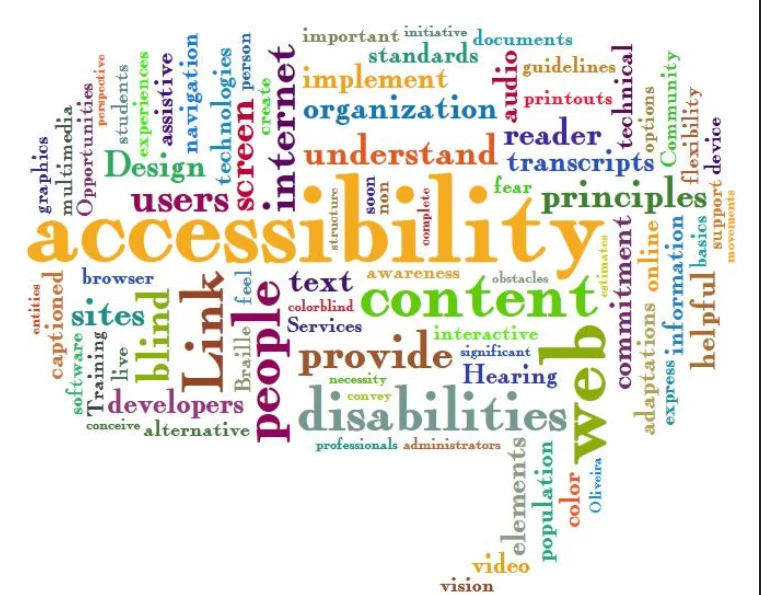Are you considering implementing new programs, technology, or resources to enhance visitor experience for differently abled patrons? If your answer is yes, there are a few key points to remember: respect the community you are serving; ensure the changes are mission oriented; confirm ADA compliance; and install measurable methods of evaluation.
“Nothing about us without us:” communicate with the audience you’re targeting to ensure your program or resources are needed and wanted.
President Bush Signs ADA, Wikimedia Commons, Licensed under CC
“Nothing about us without us” has been used since the 1980s by disability rights advocates, leading up to and beyond President George H.W. Bush’s signing of the Americans with Disabilities Act in 1990.[1] The motto is crucial to remember when planning new programs or resources for differently abled patrons. At its core, the motto means that institutions and policy/law makers should not make any decisions about differently abled individuals without talking to them and understanding what they need and what consequences may arise from careless changes. New programs and resources to enhance accessibility must begin with the community your organization is trying to serve. Administering surveys, leading focus groups, and bringing on a consultant from the community are all positive strategies to create trust with the community you are attempting to serve.
Keep your mission at the forefront of decision-making.
Any new program or resource to the organization should be mission-driven. In the planning process, the committee must ask the question “Are we doing this to check an ADA box or are we doing it because it aligns with and reinforces our mission and vision?” Hopefully, the answer is the latter. Developing a new educational/community program or installing new technology meant to increase accessibility should not be done simply to check a box. Rather, it should be carefully planned and executed to support a specific audience, which then drives the museum’s mission and vision.
Adhere to the Guidelines of Americans with Disabilities Act.
New programs and resources must be up-to-date with ADA guidelines. Furthermore, as ADA guidelines are updated, the museum must continue to evaluate them after launch to ensure that compliance continues.
Measure Success of the Program or Resource through Evaluation.
How will you know if the new program/resource is achieving the intended outcome? To answer this question, install measurable methods of evaluation for each new program and resource. Analysis of the gathered data may lead to promising adjustments of the program/resource.
The Warhol Museum in Pittsburgh, Pennsylvania is a great example of an institution that has implemented these ideas. Their ‘Out Loud’ app is part of a larger initiative to make the museum more accessible and foster deeper engagement between patrons and the collection. At the beginning of the planning process for the accessibility initiative, the museum hosted focus groups that included community members who identify as having disabilities, their family members, and professionals working in occupational therapy.
To make changes, the museum went to their targeted audience to work with them. Furthermore, the updated accessibility program furthers the museum’s mission “to engage and inspire through Warhol’s life, art, and legacy,”[2] because the stories about Warhol in the ‘Out Loud’ app and 3D printed copies of highlighted works, for example, provide opportunities for deeper engagement for a wider audience. Additionally, given the extensive research put into the initiative, the new programs are ADA compliant. Finally, the museum is fine tuning metrics to measure the success of the program.[3]
Implementing new accessibility programs may at first seem confusing and intimidating. While there could be other avenues to be explored which may result in programs that are just as exciting, following these tips and using existing successful programs as models will help make the process smoother. Questions? Check out “ADA resources for Museums, Arts, and Cultural Institutions.”
Bibliography
ADA National Network. “ADA resources for Museums, Arts, and Cultural Institutions.” ADA National Network. Revised 9 April 2012. Accessed 12 Nov. 2018. http://www.adainfo.org/sites/default/files/Arts-Museums-Cultural-Inst-ADA-Resources-4-12-12.pdf.
Cooper Hewitt Museum. “Cooper Hewitt Presents ‘Access+Ability’ with more than 70 empowering designs.” Cooper Hewitt Museum. Accessed 8 Nov. 2018. https://www.cooperhewitt.org/2017/11/27/cooper-hewitt-presents-accessability-featuring-more-than-70-inclusive-designs/.
Kenny, Amy. “Yukon Human Rights Commission offers free training on disability rights.” Yukon News. Published 8 Nov. 2018. Accessed 13 Nov. 2018. https://www.yukon-news.com/news/yukon-human-rights-commission-offers-free-training-on-disability-rights/.
Lombard, Samantha. “8 ways in which the Americans with Disabilities Act changed everyone’s lives.” Smithsonian: National Museum of American History. Published 29 June 2018. Accessed 13 Nov. 2018. https://www.si.edu/object/posts_cc942f3d12dead95ca452312b034897b?width=85%25&height=85%25&iframe=true&destination=sisearch/articles%3Fedan_q%3Ddisability%252Bservices.
Nutting, Diana. “Creating Community for All.” Smithsonian Folk Life Festival Blog. Published 25 Aug. 2017. Accessed 13 Nov. 2018. https://festival.si.edu/blog/creating-community-for-all.
Ott, Katherine. “Celebrating 25 years of the Americans with Disabilities Act.” Smithsonian: National Museum of American History. Published 1 July 2015. Accessed 12 Nov. 2018. https://www.si.edu/object/posts_8bb7c2567be62fde89792d3edf93164d?width=85%25&height=85%25&iframe=true&destination=sisearch/articles%3Fedan_q%3Ddisability%252Bservices.
Peterson, Julie. “Smashing barriers to access: Disability activism and curb cuts.” Smithsonian: National Museum of American History. Published 15 July 2015. Accessed 13 Nov. 2018. https://www.si.edu/object/posts_15f53ddc6ec5b033f596a65209617732?width=85%25&height=85%25&iframe=true&destination=sisearch/articles%3Fedan_q%3Ddisability%252Bservices.
Sakamoto, Dan. “The Warhol ‘Out Loud’ Interview with the author.” 8 Dec. 2018.
Scotch, Richard K. “Nothing about Us without Us: Disability Rights in America.” OAH Magazine of History 22 no. 3 (July 2009): 17-22. JSTOR. Accessed 13 Nov. 2018.
Shivayogi, Preethi. “Vulnerable populations and methods for their safeguard.” Perspectives in Clinical Research 4 no. 1 (2013): 53-57. Web. Accessed 13 Nov. 2018. https://www.ncbi.nlm.nih.gov/pmc/articles/PMC3601707/.
The Warhol Museum. “Museum.” The Warhol Museum, https://www.warhol.org/museum/. Accessed 10 Dec. 2018.
[1] Scotch. “Nothing about Us without Us: Disability Rights in America.”
[2] The Warhol. “Museum.”
[3] Sakamoto, Dan. “The Warhol ‘Out Loud’ Interview with the author.”


